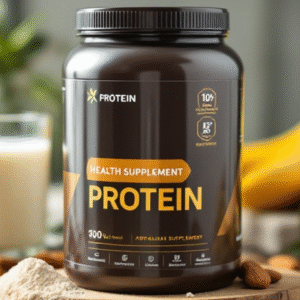
Understanding Muscle Growth
Muscle growth, or hypertrophy, is a complex process that involves the interplay of several factors, including resistance training, nutrition, and rest. When you engage in strength training exercises, you create micro-tears in your muscle fibers. The body repairs these tears during rest periods, leading to muscle growth and increased strength. Protein plays a crucial role in this repair process.
The Role of Protein in Muscle Repair
Protein is composed of amino acids, which are the building blocks of muscle tissue. When you consume protein, your body breaks it down into amino acids, which are then used to repair and build new muscle fibers. This process is known as muscle protein synthesis (MPS). To maximize MPS, it’s important to consume an adequate amount of protein throughout the day.
Recommended Protein Intake
For individuals looking to build muscle, the recommended protein intake is typically between 1.6 to 2.2 grams of protein per kilogram of body weight per day. This range supports muscle repair and growth while also fulfilling other bodily functions. For example, a person weighing 70 kg should aim for 112 to 154 grams of protein daily.
The Role of Protein Shakes
Protein shakes are a convenient and efficient way to meet your daily protein requirements, especially if you have a busy lifestyle or find it challenging to consume enough protein through whole foods alone. They are particularly beneficial post-workout when your muscles are most receptive to nutrients.
Types of Protein Shakes
There are several types of protein shakes available, each with its own benefits:
- Whey Protein: Derived from milk, whey protein is one of the most popular and effective protein supplements. It is quickly absorbed by the body, making it ideal for post-workout recovery.
- Casein Protein: Also derived from milk, casein protein is a slow-digesting protein that provides a steady release of amino acids over several hours. It is often consumed before bedtime to support overnight muscle repair.
- Plant-Based Proteins: These include proteins derived from sources like peas, rice, hemp, and soy. They are suitable for vegetarians and vegans and can be just as effective as animal-based proteins when consumed in adequate amounts.
- Egg White Protein: Made from the whites of eggs, this protein is a complete protein source, meaning it contains all essential amino acids. It is a good option for those who are lactose intolerant.
Timing Your Protein Shakes
The timing of protein intake can influence muscle growth and recovery. Here are some key times to consider consuming protein shakes:
- Post-Workout: Consuming a protein shake within 30 minutes after your workout can significantly aid in muscle recovery. This is when your muscles are most in need of amino acids to repair and grow.
- Between Meals: If you find yourself falling short of your protein goals, adding a protein shake between meals can help bridge the gap. This ensures a steady supply of amino acids to your muscles throughout the day.
- Pre-Bedtime: A slow-digesting protein shake, like one made with casein, can provide your muscles with a steady supply of protein overnight, promoting recovery and growth while you sleep.
Balancing Protein Shakes with Whole Foods
While protein shakes are convenient, they should not replace whole foods. Whole foods provide a variety of nutrients that are essential for overall health and muscle growth. Foods like chicken, fish, eggs, dairy, legumes, and grains not only offer protein but also vitamins, minerals, and healthy fats.
Creating High-Protein Meals
Incorporating high-protein meals into your diet can help ensure you’re meeting your nutritional needs. Here are some meal ideas:
- Grilled Chicken with Quinoa and Vegetables: This meal provides a good balance of protein, carbohydrates, and healthy fats.
- Salmon with Sweet Potato and Asparagus: Salmon is rich in omega-3 fatty acids, which have anti-inflammatory properties and support muscle recovery.
- Lentil Soup with Whole-Grain Bread: Lentils are a great plant-based protein source, and whole-grain bread adds fiber and additional nutrients.
Avoiding Overconsumption
It’s important to remember that consuming excessive protein won’t necessarily lead to more muscle gain. Your body can only utilize a certain amount of protein at a time, and any excess is either stored as fat or excreted. Overconsumption can also put a strain on your kidneys and liver.
Monitoring Your Protein Intake
Keep track of your daily protein intake to ensure you’re consuming an appropriate amount. Use a food diary or a nutrition app to log your meals and protein shakes. This can help you stay on track and make adjustments as needed.
Potential Drawbacks of Protein Shakes
While protein shakes can be beneficial, there are some potential drawbacks to be aware of:
- Digestive Issues: Some people may experience digestive issues like bloating, gas, or diarrhea when consuming protein shakes, especially if they are lactose intolerant or have a sensitivity to certain ingredients.
- Added Sugars and Artificial Ingredients: Some protein shakes contain added sugars, artificial sweeteners, and other ingredients that may not be beneficial for your health. It’s important to read labels and choose high-quality protein powders with minimal additives.
- Cost: High-quality protein powders can be expensive, and relying heavily on protein shakes can increase your overall food costs. It’s often more cost-effective to get the majority of your protein from whole foods.
Practical Tips for Incorporating Protein Shakes
Here are some practical tips for incorporating protein shakes into your diet:
- Choose the Right Protein Powder: Select a protein powder that fits your dietary needs and preferences. Look for options with minimal additives and high protein content per serving.
- Experiment with Flavors and Recipes: Protein shakes don’t have to be boring. Experiment with different flavors and recipes to keep things interesting. You can add fruits, vegetables, nut butters, and other ingredients to create delicious and nutritious shakes.
- Plan Your Protein Intake: Plan your meals and snacks to ensure you’re meeting your protein needs throughout the day. Use protein shakes as a supplement to whole foods, not a replacement.
- Stay Hydrated: Drinking enough water is important for overall health and can help prevent digestive issues associated with protein shakes. Aim to drink at least 8 cups of water per day, or more if you’re active.
Conclusion
Incorporating protein shakes into your diet can be an effective way to support muscle growth, but moderation and balance are key. Aim to meet your protein needs through a combination of whole foods and protein shakes, and adjust your intake based on your activity level and goals. By doing so, you’ll be well on your way to achieving your muscle-building aspirations.
Remember, building muscle is a gradual process that requires consistency and dedication. Along with proper nutrition, make sure to follow a well-structured resistance training program and get adequate rest to allow your muscles to recover and grow. If you have any specific dietary concerns or health conditions, consider consulting with a registered dietitian or nutritionist to create a personalized plan that meets your needs.
Please take a look to our Building Muscle Category: https://titisfitness.com/category/building-muscles/
Please take a look to our high protein meals: https://titisfitness.com/category/meals/






